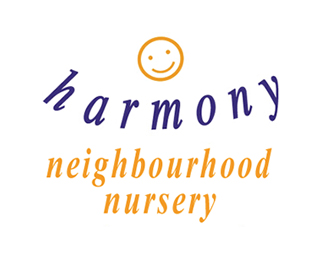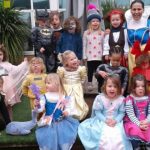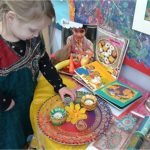-
According to Tina Bruce an author and an Early Years specialist states that “Play acts as a forward feed mechanism into courageous, creative, rigorous thinking in adulthood." Therefore, play is the focus component in our teaching and learning approach.
-
- A holistic and detailed knowledge of the children in their home context as well as the nursery is undertaken with an accurate reflection of the child. This helps the Key Person and other practitioners to focus on the child’s strengths and needs.
- We follow the Early Years Foundation Stage Guidance,
- Under the seven areas of learning, every activity has a clear purpose and learning intention.
- Lesson plans identify the objectives necessary to meet the specific targets and goals.
- All learning activities are evaluated regularly to ascertain whether the required learning took place.
- Observations of children’s learning are carried out to inform our planning and to differentiate, extend and to provide additional support.
- Each available space is used effectively promoting each of the areas of learning, including display of posters, children’s work, natural resources and permanent musical instruments.
-
Our Golden Rules
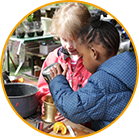

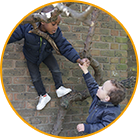
Take Turns
Listen to each other
Be kind to each other
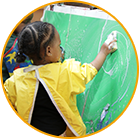
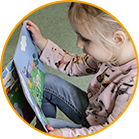
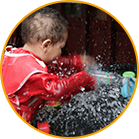
Help tidy up
Look after our books
Have fun
-
Example of our Focus Plan
Activity/Experience Heading:
Investigate Seeds & PlantsDuration of Session: 45 minutes
Aim of Activity/Experience:
- Observe different seeds
- Look at similarities and differences
- How they germinate & different ways to germinate seeds
Children’s previous experience related to this activity:
EYFS areas of learning and development objectives:
- Shows interest in different occupations 30-50 pg 38
- Can talk about some of the things they have observed 30-50 pg40
- Developing & understanding of growth 30-50 pg40
- Show care and concern for living things 30-50 pg40
- Looks closely at similarities, differences 40-60+ pg40
Early Learning Goal
Children make observation of plants, explain & talk about changes pg40
Needs of individual children / differentiation of activity to meet the children’s needs
Differentiation and needs of child:
- Give children enough time to explore.
- Have a selection of seeds (big, small & textured seeds).
- Extend language.
Health and safety aspects (Risk Assessment):
- Children are well supervised when exploring & investigating
- When using gardening tools
- When opening seeds with knife
Activity/Experience
Teaching Points
Resources
Assessment
- Investigating & exploring seeds
- Looking at texture
- Planting salads & veg
- Germinating seeds
- Observe the changes of seed, plants & nature
- Observe how roots develop when cuttings are put in water
- Make bird feeder and bird bath
- Looking at bugs & inserts
- Making a wormory
- Make a planting pond
- Build decomposition column
New words
Fragrance, stem, stalk, root, bud, sprouting, leaving, blossom, petal, pollen, pollination, germinating, decomposing
Shape, pattern & texture of seeds
– Big, small, round, tear, flat, oval, rough, smooth, shiny, fluffy, hard, soft
– How to grow & care about plants/nature
Different names of birds
– Robin, Starling, Blue tit, Wood pigeon, Magpie, Sparrow, Wren, Crow
- Divided trays/ containers
- Variety of seeds (plant, veg, fruit)
- Garden tools (trowel, rake, spade)
- Soil / cotton wool
- Planting pots / clear cup
- Bottles and containers
- Plant cuttings of herbs (observe growth in water without soil)
- Planning & getting resources ready before activity
- Have display ready for investigating and exploring
Evaluation: over 2 weeks
Wk 1: Children showed interest at the investigating area using magnifying glass and observe closely the seeds and stones. Children commented when describing the texture, size and shape of the seeds and stones
Mango stone / seeds: some are hard, rough, bumpy, fluffy, fury, like baby hair, soft, smooth, the lines look like veins, big stone, biggest stone, look a bit like an oval, looks a bit like baby’s ear with baby hair.
Date stone: pointy stone / seed, is hard, makes a sound when you drop it on the floor like a stone, there is a bit of skin left on it, it has a line in the middle of the stone, it’s a bit sticky.
Pepper seed: the seed is round and flat, the red pepper is still stuck on it, this one looks like a flower (pepper seeds on the stalk), this one is the smallest seed.
Coriander seed: is a small seed; it is hard seed, looks like a small tiny ball, like a sphere shape, has line on the seed.
Chick peas: has a pointy bit on top, hard seed, it has two bumps, it’s a little bit round.
Pumpkin seed: some are hard, flat and one is smooth, looks like a pear shape, a bit like a tear drop, these pumpkin seeds are different in colour, shape and sizes.
Avocado stone: big round ball shape, its a sphere shape, it’s a hard stone, it makes a cracking sound when you squeeze it, it has skin peeling off, inside is orange, soft and smooth.
Butter beans: shiny and hard, it’s a big bean, a bit like an oval shape.
After seeds were soaked the children were using the language e.g. the butter bean skin has come off, it’s like a bit like fluffy cotton wool, looks a bit like pasta, chick peas looks a bit puffy.Next Step
Planting salad.
Watch seeds germinate in cotton wool and soil and how to transplant them into beddings.
Observe growth of plant cutting.Reflection
Having a large selection of seeds and stones kept children engaged for a long period of time at the investigation area and using magnifying glass to help them look more closely at the seeds and stones.
